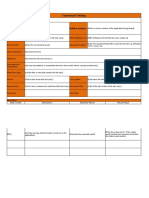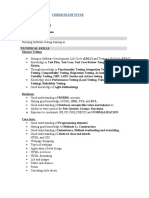0 ratings0% found this document useful (0 votes)
16 viewsSlidesgo Python 101 An Introduction To The Basics of Programming With Python 20241023045143xPLW
ghffg
Uploaded by
captianmac12Copyright
© © All Rights Reserved
Available Formats
Download as PDF, TXT or read online on Scribd
0 ratings0% found this document useful (0 votes)
16 viewsSlidesgo Python 101 An Introduction To The Basics of Programming With Python 20241023045143xPLW
ghffg
Uploaded by
captianmac12Copyright
© © All Rights Reserved
Available Formats
Download as PDF, TXT or read online on Scribd
You are on page 1/ 14
Python 101: An Introduction to the
Basics of Programming with
Python
Introduction to Python
Welcome to Python 101! In this
presentation, we will explore the basics of
programming with Python. This powerful
language is known for its simplicity and
versatility, making it an ideal choice for
beginners. Let's embark on this journey to
learn how to code effectively!
What is Python?
Python is a high-level, interpreted
programming language created by Guido
van Rossum. It emphasizes code
readability and allows programmers to
express concepts in fewer lines of code. Its
extensive libraries and community support
make it suitable for various applications,
from web development to data analysis.
Why Learn Python?
Python is widely used in industry and
academia due to its flexibility and ease of
learning. It is an excellent choice for
beginners and experienced developers
alike. Python's applications range from
data science to machine learning, making
it a valuable skill in today's job market.
Setting Up Python
To get started with Python, you need to
install the Python interpreter. You can
download it from the official Python
website. After installation, you can use an
Integrated Development Environment
(IDE) like PyCharm or Jupyter Notebook to
write and execute your Python code
efficiently.
Basic Syntax
Python uses a simple and clear syntax that
is easy to understand. For example, to print
text, you can use the print() function.
Indentation is crucial in Python, as it
defines the structure of your code.
Mastering the syntax is the first step to
becoming proficient in Python
programming.
Data Types
Python supports various data types,
including integers, floats, strings, and
booleans. Understanding these types is
essential, as they determine how data is
stored and manipulated. You can perform
operations on these data types, making
Python a powerful tool for programming.
Variables and Constants
In Python, you can create variables to store
data values. A variable can be changed
during program execution, while a
constant remains fixed. Naming
conventions are important; variable names
should be descriptive and follow the
snake_case format for better readability.
Control Structures
Control structures like if statements, for
loops, and while loops allow you to control
the flow of your program. These structures
enable you to make decisions and repeat
actions based on specific conditions,
which is fundamental in programming
logic.
Functions
Functions are reusable blocks of code that
perform specific tasks. In Python, you can
define your own functions using the def
keyword. Functions help organize code,
reduce redundancy, and enhance
readability by encapsulating logic into
manageable sections.
Handling errors gracefully is crucial in programming. Python uses try-except
blocks to catch exceptions and prevent program crashes. By implementing error
handling, you can ensure that your program runs smoothly even when
unexpected issues arise.
Libraries and Frameworks
Python has a rich ecosystem of libraries
and frameworks that extend its
capabilities. Popular libraries include
NumPy for numerical computations and
Pandas for data manipulation.
Familiarizing yourself with these tools can
significantly enhance your programming
efficiency.
Conclusion
Congratulations on completing Python
101! You now have a foundational
understanding of Python programming.
Continue practicing and exploring more
advanced topics to enhance your skills.
Remember, the key to becoming
proficient is consistent practice and
curiosity!
Thanks!
Do you have any questions?
youremail@email.com
+91 620 421 838
www.yourwebsite.com
@yourusername
You might also like
- Python Programming for Beginners_ From Basics to AI Integrations. 5-Minute Illustrated Tutorials, Coding Hacks, Hands-On Exercises & Case Studies to Master Python in 7 Days and Get Paid More by Prince100% (4)Python Programming for Beginners_ From Basics to AI Integrations. 5-Minute Illustrated Tutorials, Coding Hacks, Hands-On Exercises & Case Studies to Master Python in 7 Days and Get Paid More by Prince244 pages
- 2.system Configuration Hardware Requirements: Processor Intel Pentium 3805u @1.90ghzNo ratings yet2.system Configuration Hardware Requirements: Processor Intel Pentium 3805u @1.90ghz51 pages
- Mastering Python: Learn Python Step-by-Step with Practical ProjectsFrom EverandMastering Python: Learn Python Step-by-Step with Practical ProjectsNo ratings yet
- Want To Know More About Python Programming? Tonex Offers, A 5-Day Course DNo ratings yetWant To Know More About Python Programming? Tonex Offers, A 5-Day Course D1 page
- Expert Python Programming - Second Edition - Sample Chapter50% (6)Expert Python Programming - Second Edition - Sample Chapter40 pages
- Introduction To Algorithms and Python by Wilbert RibeiroNo ratings yetIntroduction To Algorithms and Python by Wilbert Ribeiro5 pages
- Download full Your First Python Program Alexander Paz ebook all chapters100% (2)Download full Your First Python Program Alexander Paz ebook all chapters37 pages
- Python Tutorial - Learn Python Programming For FreeNo ratings yetPython Tutorial - Learn Python Programming For Free6 pages
- The Best Python Programming Step-By-Step Beginners Guide Easily Master Software engineering with Machine Learning, Data Structures, Syntax, Django Object-Oriented Programming, and AI applicationFrom EverandThe Best Python Programming Step-By-Step Beginners Guide Easily Master Software engineering with Machine Learning, Data Structures, Syntax, Django Object-Oriented Programming, and AI applicationNo ratings yet
- Essential Guide To Python For All Levels (2024 CollectionNo ratings yetEssential Guide To Python For All Levels (2024 Collection184 pages
- Learn Python Programming For Beginners B08X4CXRRP100% (8)Learn Python Programming For Beginners B08X4CXRRP131 pages
- Content Page - Cict Thesis Manuscript TemplateNo ratings yetContent Page - Cict Thesis Manuscript Template19 pages
- Computer Science Complementary For B.SC Life ScienceNo ratings yetComputer Science Complementary For B.SC Life Science22 pages
- Oracle Integration Cloud Service Reviews, Tips, and Advice From Real Users March 2021No ratings yetOracle Integration Cloud Service Reviews, Tips, and Advice From Real Users March 202122 pages
- Java Lab Assignments 2nd Year EngineeringNo ratings yetJava Lab Assignments 2nd Year Engineering20 pages
- Chapter 1 - Introduction To Programming and FlowchartingNo ratings yetChapter 1 - Introduction To Programming and Flowcharting33 pages
- A Guide To Getting Started With Boost - Asio - They Don't Teach This Stuff in SchoolNo ratings yetA Guide To Getting Started With Boost - Asio - They Don't Teach This Stuff in School99 pages
- COMP 310 INTE 221 BBIT 221 COSF 124 WEB PROGRAMMING - Kabarak UniversityNo ratings yetCOMP 310 INTE 221 BBIT 221 COSF 124 WEB PROGRAMMING - Kabarak University5 pages
- Functional Testing System and Integration Test 1: IRCTC Web ApplicationNo ratings yetFunctional Testing System and Integration Test 1: IRCTC Web Application8 pages
- Pega Robotic Automation Agile Desktop Implementation GuideNo ratings yetPega Robotic Automation Agile Desktop Implementation Guide60 pages
- Python Programming for Beginners_ From Basics to AI Integrations. 5-Minute Illustrated Tutorials, Coding Hacks, Hands-On Exercises & Case Studies to Master Python in 7 Days and Get Paid More by PrincePython Programming for Beginners_ From Basics to AI Integrations. 5-Minute Illustrated Tutorials, Coding Hacks, Hands-On Exercises & Case Studies to Master Python in 7 Days and Get Paid More by Prince
- 2.system Configuration Hardware Requirements: Processor Intel Pentium 3805u @1.90ghz2.system Configuration Hardware Requirements: Processor Intel Pentium 3805u @1.90ghz
- Mastering Python: Learn Python Step-by-Step with Practical ProjectsFrom EverandMastering Python: Learn Python Step-by-Step with Practical Projects
- Want To Know More About Python Programming? Tonex Offers, A 5-Day Course DWant To Know More About Python Programming? Tonex Offers, A 5-Day Course D
- Python Made Simple: A Practical Guide with ExamplesFrom EverandPython Made Simple: A Practical Guide with Examples
- Expert Python Programming - Second Edition - Sample ChapterExpert Python Programming - Second Edition - Sample Chapter
- Introduction To Algorithms and Python by Wilbert RibeiroIntroduction To Algorithms and Python by Wilbert Ribeiro
- Python Unleashed: Mastering the Art of Efficient CodingFrom EverandPython Unleashed: Mastering the Art of Efficient Coding
- Download full Your First Python Program Alexander Paz ebook all chaptersDownload full Your First Python Program Alexander Paz ebook all chapters
- Python Tutorial - Learn Python Programming For FreePython Tutorial - Learn Python Programming For Free
- The Best Python Programming Step-By-Step Beginners Guide Easily Master Software engineering with Machine Learning, Data Structures, Syntax, Django Object-Oriented Programming, and AI applicationFrom EverandThe Best Python Programming Step-By-Step Beginners Guide Easily Master Software engineering with Machine Learning, Data Structures, Syntax, Django Object-Oriented Programming, and AI application
- Essential Guide To Python For All Levels (2024 CollectionEssential Guide To Python For All Levels (2024 Collection
- Computer Science Complementary For B.SC Life ScienceComputer Science Complementary For B.SC Life Science
- Oracle Integration Cloud Service Reviews, Tips, and Advice From Real Users March 2021Oracle Integration Cloud Service Reviews, Tips, and Advice From Real Users March 2021
- Chapter 1 - Introduction To Programming and FlowchartingChapter 1 - Introduction To Programming and Flowcharting
- A Guide To Getting Started With Boost - Asio - They Don't Teach This Stuff in SchoolA Guide To Getting Started With Boost - Asio - They Don't Teach This Stuff in School
- COMP 310 INTE 221 BBIT 221 COSF 124 WEB PROGRAMMING - Kabarak UniversityCOMP 310 INTE 221 BBIT 221 COSF 124 WEB PROGRAMMING - Kabarak University
- Functional Testing System and Integration Test 1: IRCTC Web ApplicationFunctional Testing System and Integration Test 1: IRCTC Web Application
- Pega Robotic Automation Agile Desktop Implementation GuidePega Robotic Automation Agile Desktop Implementation Guide

























































































